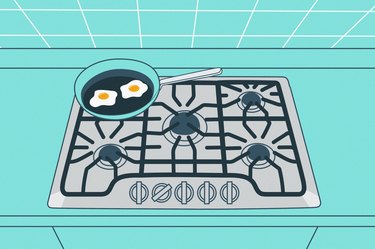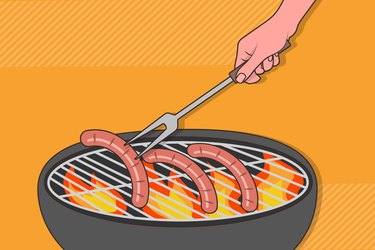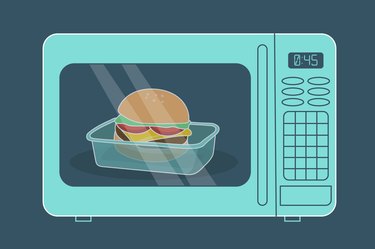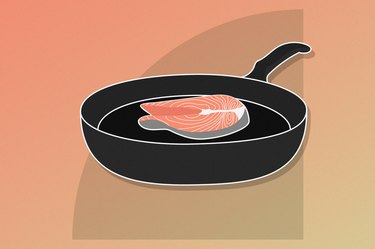
A stove is the centerpiece of your kitchen. Like your refrigerator, it's an appliance that's used a lot. That ever-present quality can make your range feel unremarkable — but in recent years, gas stoves have become the subject of headlines and legislation.
Many cities — including New York, Los Angeles and Berkeley — recently banned gas stoves (along with gas-powered heaters and boilers) from new buildings, with Berkeley being the first to enact this type of ordinance in 2019.
Video of the Day
Video of the Day
And, in 2022, the American Medical Association (AMA) passed a resolution calling for education about the health-related risks of gas stoves, along with supporting programs to encourage an equitable transition to electric stoves.
If you're part of the roughly 35 percent of Americans who use a gas stove, per the U.S. Energy Information Administration, here's what you need to know.
How Gas Stoves Can Affect Your Health
When you cook food using a gas stove, it leads to the emission of carbon monoxide, various pollutants, formaldehyde and particulate matter, says Qunfang (Zoe) Zhang, an air pollution specialist at the Health and Exposure Assessment Branch in the California Air Resources Board's Research Division: Air.
This affects the quality of the air inside your home — and that, in turn, can affect your health.
"These gas byproducts may be implicated in causing or exacerbating respiratory illness," says Jonathan Moore, MD, a pulmonology fellow at Lenox Hill Hospital.
NOx
At the center of the conversation: Nitrogen oxides (NOx), which includes both nitric oxide (NO) and nitrogen dioxide (NO2), per the U.S. Department of Energy.
Exposure to nitrogen dioxide is hard on people with asthma and increases the risk of respiratory infections, according to the Environmental Protection Agency (EPA). And using a gas stove can lead to nitrogen dioxide levels that exceed both indoor and outdoor standards, per a 2020 report from the Rocky Mountain Institute, a nonprofit organization focused on a move to clean energy.
Nitrogen dioxide can lead to significant inflammation in the lungs, says William Checkley, MD, PhD, who specializes in intensive care medicine and is currently researching the association between household air pollution and lung function.
There's a link between nitrogen dioxide and COPD, per a May 2018 meta-analysis in Environmental Science and Pollution International.
And, for children, growing up in a home with a gas stove is tied to a 42 percent higher risk of having asthma currently and a 24 percent higher risk of developing it during their lifetime, per an August 2013 meta-analysis in the International Journal of Epidemiology.
Particulate Matter
Cooking with heat leads to the formation of particulate matter, or teensy-tiny particles in the air. The smaller the particles, the bigger the concern because they can more easily be inhaled, per the EPA.
Once you breathe in particulate matter, it can then affect your heart and lungs, according to the EPA.
And, while all cooking may lead to the release of particulate matter, gas stoves lead to higher amounts than electric ones, per a May 2017 study in the Science of the Total Environment. Other factors, such as cooking method, burner size, cooking oil and more, may also affect the volume and size of particulate matter.
Carbon Monoxide
Often deemed the silent killer, carbon monoxide is a gas that can be deadly at high levels, Zhang says. But low or moderate levels of carbon monoxide can also have health effects. These range from fatigue to impaired brain function, according to the EPA.
Carbon monoxide levels are higher in homes with gas stoves than homes that don't have one — and they're higher still near poorly adjusted stoves, according to the EPA.
Especially if you have a gas stove (or any other gas appliance) in your home, make sure you also have a carbon monoxide detector. You should have one on each floor, according to the EPA, and it should ideally be placed near your sleeping area.
Greenhouse Gasses
Plus, there's the environmental impact of burning gas, Dr. Checkley says. "Burning gas in itself is leading to a carbon footprint," he says.
Gas stoves release the greenhouse gas methane — even when they're not in active use, according to a January 2022 study in Environmental Science and Technology.
Across all homes with gas stoves in the United States, the amount of methane released each year could have a similar environmental effect as the carbon dioxide emissions of half a million cars, per the study.
Putting It All Together
Here's what we can conclude about gas stoves: Using one — particularly without ventilating (more on that in a moment) — has a real effect on indoor air quality. And that air plays a similar role to outdoor air when it comes to developing or exacerbating pulmonary disease, Dr. Moore says.
"However, establishing a causal link between indoor cooking with gas stoves and development of respiratory illnesses is limited based on the study methodologies," Dr. Moore says. That is, isolating the effect of a gas range from other factors that might contribute to asthma and other respiratory conditions is challenging.
"Asthma, and most diseases in general, is a complex interaction between an individual's genetics, environment and exposures," Dr. Moore says.
Ventilation Is Key
If using a gas stove causes a variety of unpleasant gasses and other pollutants to gather in the air inside your home, one important strategy is to usher these pollutants outdoors.
To do that, use a range hood that vents outside, according to the California Air Resource Board (ARB). Use the back burners when possible since the vent works most effectively on them, per ARB.
Most importantly: If you have a vent, use it whenever you cook.
In one small study, which looked at 71 residences in California for a week, range hoods were only used 36 percent of the time while cooking in homes, and 28 percent of the time in apartments, per the December 2020 research in the International Journal of Environmental Research and Public Health.
Not everyone has a range hood, and if you're a tenant, getting one in place may not be possible. In that case, take up other strategies to ventilate, like opening windows and doors and using fans, according to ARB.
So, Is Using a Gas Stove Dangerous?
That's hard to determine. Gas stoves likely produce more indoor air pollutants than electric ones.
"There is an idea that electric stoves would probably produce less of these pollutants, and definitely there would be a greenhouse gas benefit," says Patrick Wong, a manager in the California Air Resources Board's Research Division: Air.
But, more work is needed to connect the dots, Wong says.
The AMA resolution goes far, saying "our American Medical Association recognizes the association between the use of gas stoves, indoor nitrogen dioxide levels and asthma." And the resolution further encourages implementing mitigation strategies.
None of the experts suggested discarding a stove as the immediate answer. In fact, Dr. Checkley uses a gas stove with the range hood on to avoid exposure to byproducts at his home.
The reality is, many things — including health, affordability, accessibility and personal preference — affect your choice when it comes to a stove, Zhang says. Price is a huge factor. And for renters, a switch to electric isn't always feasible.
The final part of the AMA resolution: A call to advocate for programs that help make the transition from gas to electric stoves equitable.
Top-Rated Electric Stoves to Shop
- GE Electric Range With Self-Cleaning Oven ($718, Home Depot)
- GE Electric Range With Self-Cleaning Convection Oven and Air Fry ($848, Home Depot)
- Frigidaire Electric Range, True Convection Self-Cleaning Oven With Air Fry ($898, Home Depot)
What to Know Before You Cook With an Electric Stove
If you do opt to transition to an electric stove, be prepared to feel like a newbie cook once again. Here's what you need to know:
Electric vs. Induction
There's a difference between electric stoves, which may have classic metal coils or a heated element in a smooth surface, and induction stovetops.
Both types are powered by electricity, but a standard (or coil) electric range works by creating heat, some of which goes into the air and some of which heats the cookware, says Rachelle Boucher, executive chef and electric kitchens expert at Kitchens to Life. Induction, on the other hand, has a copper coil that makes a magnetic connection to pots and pans, heating them up, she says.
The result: an increase in heat efficiency, which means that the kitchen may feel less steamy and a pot of water will come to a boil incredibly quickly, Boucher says. Plus, you can put a piece of paper next to the induction burner and it won't go up in flames. Only the pot gets hot, she says.
Keep in mind that you may need to swap out some of your cookware with these types of stoves (more on that in a minute).
Get Accustomed to New Ways to Regulate Heat
With any type of electric stove — induction or coil — you lose the ability to gauge the heat level by looking at the flames.
That can feel challenging at first. But with time, you'll adjust, taking your cues from the food, Boucher says. You'll know to increase or decrease the heat by the sizzle of your onions or the bubbles appearing around the edges of pancakes.
A standard electric stove may demand further adjustments. For instance, you won't have instant heat with a standard electric stove, says Roger Sitrin, lead recreational chef instructor at the Institute of Culinary Education. Unlike a gas stove, where the flame responds immediately to dial adjustments, "with electric stoves, you must allow the element time to heat up and cool down," Sitrin says.
Once the electric stove is on, it'll cycle — as an oven does — to maintain the heat, he says. And even when you turn it off, a standard electric stove will remain hot.
"When cooking on electric stoves, you must move the pan off the element when you want to stop the cooking process," Sitrin says.
With an induction stove, these hacks aren't necessary. That's because induction offers both instantaneous heat and instant cooling, along with more control than either gas or electric ranges, Boucher says.
Your Pots and Pans May Need an Update
For an induction stove, nearly all the pots and pans you already use — a dutch oven, cast-iron, nonstick and so on — will work. (Although you should keep in mind that cast iron pans can easily scratch ceramic or glass surfaces.)
All aluminum or all copper pans won't work, but clad copper will, she says.
With a standard electric stove, you may need to make some adjustments.
"Old, thin, banged up pans won't work so well on your electric stove," Sitrin says. Opt for enameled cast iron pans, copper pans and clad pans with multiple layers, he says. And make sure they have a flat bottom, to connect with the range, he adds.
Tip
You can confirm if a piece of cookware will work on an induction stove by trying to put a magnet on the bottom, Boucher says. “As long as a magnet sticks to the bottom of the pan [it’ll work],” she says.
On an Electric Range, Try Using Multiple Burners for the Best Effect
Going from a rapid boil to a simmer can be hard on an electric range because the element maintains heat, Sitrin points out.
"I've gotten around this by using two burners. I set one on high for boiling and then a second on simmer, then move my pot from the hot burner to the cooler one," he says.
- The New York City Council: "Use of substances with certain emissions profiles."
- Los Angeles Times: "L.A. is banning most gas appliances in new homes. Get ready for electric stoves"
- The Guardian: "Berkeley became first US city to ban natural gas. Here's what that may mean for the future"
- Environmental Protection Agency: "Nitrogen Dioxide's Impact on Indoor Air Quality"
- Rocky Mountain Institute: "Gas Stoves: Health and Air Quality Impacts and Solutions"
- Environmental Science and Pollution International: "Exposure to nitrogen dioxide and chronic obstructive pulmonary disease (COPD) in adults: a systematic review and meta-analysis"
- International Journal of Epidemiology: "Meta-analysis of the effects of indoor nitrogen dioxide and gas cooking on asthma and wheeze in children "
- Biomagnetic Monitoring of Particulate Matter: "Particulate Matter"
- EPA: "Indoor Particulate Matter"
- Science of the Total Environment: "Review of factors impacting emission/concentration of cooking generated particulate matter"
- Environmental Science and Technology: "Methane and NOx Emissions from Natural Gas Stoves, Cooktops, and Ovens in Residential Homes"
- California Air Resource Board: "Indoor Air Pollution from Cooking
- International Journal of Environmental Research and Public Health: "Factors Impacting Range Hood Use in California Houses and Low-Income Apartments"
- Environmental Protection Agency: "Where should I place a carbon monoxide detector?"



